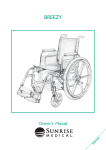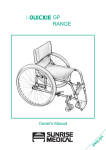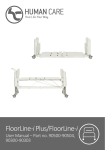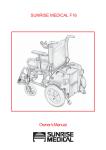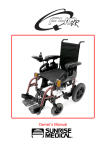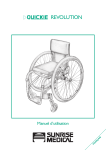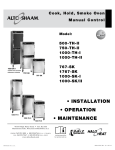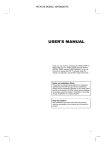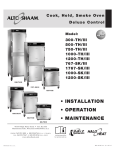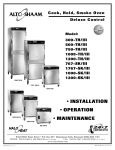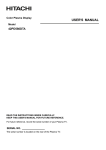Download User Manual
Transcript
RX/ RXS Owner’s Manual Issue 5 47 RX/RXS RX/RXS Height adjustable armrests illustrated How to use this manual We at Sunrise Medical want you to get the best out of your Quickie RX/RXS wheelchair. This Owner’s Manual will familiarise you with the chair and its features. It contains hints on everyday usage and general care in addition to information on the high quality standards which we adhere to and details about the guarantee. This manual gives information on all features without stating whether they are optional or standard. For this information refer to the order/prescription form or your prescriber/supplier. Your wheelchair will reach you in excellent condition having been personally inspected before leaving our factory. By following the guidelines for maintenance and cleaning on pages 39-40 your wheelchair will maintain its first class condition and give you complete satisfaction. For ease of use Warning denotes a risk of personal injury or damage to your chair and ! indicates points which will improve the performance and safety of your chair. Issue 4 RX/RXS Contents Introduction page 1 Guarantee page 2 Features and options page 3 Safety tips page 4 Using your chair page 5-16 Footrests page 17 Armrests page 18-19 Wheel locks page 20 Knee lever brakes page 21 Grade aids page 21 Backrests and Optima upholstery page 22-23 Height adjustable push handles page 23 Quick-release axles page 24 Anti-tip tubes page 24 Chair adjustments page 25 - 34 Lap belt instructions page 35 - 37 Transportation page 38 Maintenance schedule page 39 Cleaning guidelines, accessories and tools page 40 Technical data page 41 Sunrise Medical page 42 RX/RXS 46 Issue 5 Introduction Sunrise is dedicated to providing products of exacting quality which conform fully and reliably to the requirements of their intended use. This wheelchair is to be used to aid individuals with limited or no personal mobility. The Quickie RX/RXS are suitable for both indoor and outdoor use. The maximum user weight for these chairs is 113kg (250lb). Sunrise is accredited to BS EN ISO 9001, which is the internationally recognised standard for quality management systems. This approval ensures we provide quality in all areas of our business from development through to final delivery. This product is manufactured to comply with the ‘Medical Device Directive’ 93/42/EEC. If you have any queries about the use, maintenance or safety of your wheelchair please contact your wheelchair prescriber/supplier. Sunrise Medical will be pleased to answer any other questions that you may have and can provide a list of approved Sunrise Medical agents on request to: SUNRISE MEDICAL LIMITED HIGH STREET WOLLASTON WEST MIDLANDS DY8 4PS ENGLAND Telephone 01384 44 66 88 Fax. 01384 44 66 99 International Telephone +44 1384 44 66 88 Fax.+44 1384 44 66 99 www.sunrisemedical.co.uk Serial Number: Inspected by: Your local dealer: Your local dealer: Issue 5 1 RX/RXS Guarantee 7 Items of a consumable nature will not normally be covered during the 12 month warranty period unless such items have suffered undue wear as a direct result of an original manufacturing defect. These items include amongst others, lubricants, motor brushes, upholstery, tyres, inner tubes, pushhandle foam, brakes and similar parts. Batteries will be covered by the warranty only where they have been charged and maintained fully in accordance with the manufacturer’s recommendations. Your guarantee The guarantee form is included in the Sunrise Pack, which accompanies the chair on delivery. Please fill in the relevant details and return to us to register your entitlement. The guarantee is for your information. THIS IN NO WAY AFFECTS YOUR STATUTORY RIGHTS. Sunrise Medical guarantees the frame, crossbrace and wheelaxles on Quickie wheelchairs against defects in materials and workmanship for the lifetime of the original purchaser. 8 Under normal circumstances no responsibility will be accepted where the goods have required repair or replacement as a direct result of: All Quickie wheelchairs, parts and components (including frame components, axle plates, castors, armrest, backrests etc.) are guaranteed against defects in materials and workmanship for one year from purchase date. a) The goods or part not having been maintained in accordance with the manufacturer’s recommendations, where such exist and using only the specified original equipment parts. b) The goods or part having been damaged by neglect, accident or improper use. Warranty conditions c) The goods or part having been altered from the manufacturer’s specifications, or repairs having been attempted prior to the designated repairer being notified. 1 This warranty does not affect the statutory rights of the Customer but if the Customer wishes to have the benefit of the Company’s warranty the Customer must comply with the provisions set out below. 2 In the event of a defect in the goods supplied becoming apparent within the warranty period which commences from the delivery date the Company either itself or by an authorised dealer repair agent will effect any necessary repair or replacement of parts free of charge on condition that the Customer complies with the following provisions of this warranty. 3 Any part repaired or replaced during the warranty period is warranted for the remainder of the duration of that period. 4 The arrangements for repairs and service and the designated repairer will be notified to the Customer by the Company and will be confirmed at any time on request. 5 ON A DEFECT OCCURRING DURING THE WARRANTY PERIOD THE CUSTOMER MUST NOTIFY THE DESIGNATED REPAIRER IMMEDIATELY GIVING FULL INFORMATION AS TO THE PROBLEM AND NO USE MUST BE MADE OF THE GOODS AND NO ALTERATION OR UNAUTHORISED REPAIRS MADE TO THE GOODS PRIOR TO INSPECTION BY THE DESIGNATED REPAIRER. 6 If the Customer is operating the Goods away from the locality of the designated repairer the Customer must contact the Company to obtain the name and address of another repairer authorised by the Company. If the Customer is operating the Goods outside the UK the Customer must bear the transport, insurance and packaging costs incurred in having the Goods repaired or replaced by an authorised repairer of the Company. d) Fair wear and tear. Please keep a note of your local service agent’s address and telephone number in the space provided on the previous page. In the event of a breakdown, contact them and try to give all relevant details so they can help you quickly. The wheelchairs shown and described in this manual may not be exactly the same in every detail as your own model. However, all instructions are still entirely relevant, irrespective of detail differences. The manufacturer reserves the right to alter without notice any weights, measurements or other technical data shown in this manual. All figures, measurements and capacities shown in this manual are approximate, and do not constitute specifications. Please remember to fill in and post the guarantee registration card enclosed with this manual. Sunrise Medical Limited recommend that you do not undertake maintenance tasks other than those explained in this manual. Your local approved Sunrise Medical service agent is fully trained by Sunrise Medical to carry out detailed maintenance as and when required. Use only genuine Sunrise Medical replacement parts. Sunrise Medical Limited High Street, Wollaston, West Midlands DY8 4PS England Tel 01384 44 66 88 Fax 01384 44 66 99 www.sunrisemedical.co.uk RX/RXS 2 Issue 5 Features and options 2 1 4 3 5 6 15 7 14 13 1 2 3 4 5 6 7 8 Issue 5 12 10 11 Height adjustable armrest Push handle backrest tube Angle adjustable backrest Handrim Full profile tyre X spoked wheel Quick-release axles Adjustable axle plate (RXS) 9 8 8a 8a Axle bracket and threaded axle (RX) 9 Wheel lock 10 Crossbrace 11 Swing-away release catch 12 Castor fork/wheel assembly 13 Flip up footplate 14 Swing-away hanger 15 Seat sling 3 RX/RXS Safety tips Wheelies Anti-tip tubes Doing a wheelie (tilting the wheelchair backward to its balance point) is dangerous, as the chair may tip over. Wheelies should only be performed by experienced users. Do not attempt to learn or practice this manoeuvre without the aid of an attendant. Under normal use, anti-tip tubes will prevent the wheelchair from tipping over backwards. Anti-tip tubes are available from your local wheelchair prescriber/supplier. Sunrise Medical recommends antitip tubes for first time and less experienced wheelchair users. Footrests Tyre pressure The lowest point of the footrests should be at least 63mm (2½") from the ground to allow proper clearance. Never stand on the footrests because the chair may tip over. Warning: Ensure that pneumatic tyres are properly inflated. The correct tyre pressure is 450 kilopascals/4.5 bar (65 psi) for the pneumatic rear wheels and 250 kilopascals/2.5 bar (36 psi) for castor wheels. Low tyre pressure may allow the rear wheels locks to slip. Never lift the wheelchair by the swing-away footrests, or elevating legrests or armrests. These parts are detachable. Lifting the wheelchair by them may cause damage to the chair or injury to the user. Armrests Always secure swing-away armrests before using the wheelchair. Never lift the wheelchair by the armrests. These parts are detachable and lifting the wheelchair by them may cause damage to the chair and/or injury to the user. Kerbs, inclines, obstacles and ramps Always practice with a qualified attendant before attempting to negotiate kerbs, inclines or ramps alone. It is important for you to develop safe techniques suited to your abilities. Do not attempt to go up or down inclines greater than 10% (1 in 10). Transfers Guidelines on how to do a side transfer are provided in this manual, however, this is only one method of transfer and you should work with your wheelchair prescriber /supplier to develop a technique which best suits your abilities. RX/RXS 4 Issue 5 Using your chair Opening Tilt the wheelchair towards you far enough to take the weight off the opposite wheel (Fig.1). Push down with the palm of the hand on the seat rail (1) closest to you until the wheelchair has completely opened. Allow the chair to return to an upright position on all four wheels. Complete the opening procedure by now standing in front of the chair, placing the palms of your hands on both seat rails, and pressing down making sure the seat rail snaps into the rail saddles (2). 1 2 Warning: Do not place your fingers between the seat sling and frame rail during this operation. Fig. 1 Folding Flip up the footplates to a vertical position before folding the wheelchair (Fig. 2). Standing to one side of the chair, reach down and grasp the seat sling at both the front and the back between your hands. Lift sharply to disengage the seat sling rails from their frame saddles. Once disengaged continue with an upward lift until the wheelchair is completely folded. Fig. 2 Issue 5 5 RX/RXS Using your chair Water, snow and ice 3. Always use good posture and proper body mechanics. When you lift or support the rider or chair, bend your knees slightly and keep your back as upright and straight as you can. 4. Unlock and rotate anti-tip tubes up out of the way, to avoid a trip or fall, when operating the chair from the back. 5. Always lock the rear wheels and lock anti-tip tubes in the down position if you must leave the rider alone, even for a moment. Doing so will reduce the risk of a tip over or loss of control of the chair. Contact with water, snow or ice may affect the performance of your wheelchair. 1. Never use your wheelchair in a pool or other body of water. 2. If your chair becomes wet, or if you use water to clean it, dry the chair thoroughly as soon as you can. When you need assistance Warning: If you fail to heed the following warnings, a fall or tip over may occur and cause severe injury to you or to your attendant. For the Rider: You should make sure that persons who assist you, read and follow all warnings and instructions that apply to that use. Before using this chair each attendant must know what to do to ensure safety. Centre of balance Warning: The point where this chair will tip forwards, backwards or to the side depends on its centre of balance and stability. If you fail to heed these warnings a fall or tip over may occur and cause severe injury to you: For Attendants: 1. Put the rider at ease. Tell the rider what you plan to do and explain what you expect the rider to do. 2. Work with the rider’s doctor, nurse or therapist to learn safe methods best suited to your abilities and those of the rider. RX/RXS 1. The most important adjustment to your chair is the position of the rear axles. The further you move the rear axles forward, the better the chair manoeuvres, but the more likely it is that your chair will tip over backwards. ! Consult your doctor, nurse or therapist to find out what axle position is best for you. 6 Issue 5 Using your chair Dressing and changing clothes Centre of balance (continued) 2. Changing the setup of this chair increases the risk of a fall or tip over. Be very careful if you make a change to any of the following: ! The position of the rear axles, the distance between the rear wheels or the amount of rear wheel camber. ! The distance between the centre of the front castors and rear wheels and the angle of the castors. 3. To avoid a fall or tip over you should: ! Have someone help you until you know the balance points of your chair and how to avoid a tip over. ! Use anti-tip tubes until you are sure you are not at risk of tipping over. 4. The centre of balance and stability of your chair are also affected by: ! A shift in your body position, posture or weight distribution. ! Riding your chair on a sloped surface. ! Fitted seating systems. Warning: Your weight may shift if you dress or change clothes while seated in this chair. This may cause a fall or tip over and severe injury to you. To help prevent this you should: 1. Rotate the front castors to the forward position. 2. Lock anti-tip tubes in the down position if your chair has anti-tip tubes. 3. Back your chair up against a wall and lock both rear wheels. Refer to the sections that follow to learn how you can reduce the risk of a fall or tip over by proper use of this chair. Issue 5 7 RX/RXS Using your chair Wheelies (rear wheel balance) Follow these steps when learning to do a wheelie with help: A wheelie is performed by balancing on the rear wheels of your chair, while the front castors are raised off the ground. If done safely, it can help you overcome kerbs and other obstacles. 1. The attendant should be at the rear of the chair, and must be able to move with the chair to prevent a tip over. 2. The attendant’s hands should be beneath the push handles or back brace ready to catch you if you tip too far backwards. 3. When the attendant is in position, place your hands on the forward area of the handrims. 4. Make a quick backward movement of the rear wheels, immediately followed by a hard forward thrust. This will tilt the chair backwards and lift the castors from the ground. Try to find the balance point, which is the point where you will not fall backwards or forwards. 5. Maintain your balance by small movements of the handrims. Warning: It is dangerous to do a wheelie, as you may fall or tip over backwards and suffer a severe injury. Make sure that you heed these warnings: 1. Consult your doctor, nurse or therapist to find out if you are a good candidate to learn to do a wheelie. 2. Do not try to do a wheelie unless you are a highly skilled rider or unless you have help. 3. Make sure that anti-tip tubes are up, out of the way, so they do not interfere. 4. When learning to do a wheelie, make sure that this chair has push handles. The attendant needs secure points to hold the rear of the chair to prevent the user from tipping over backwards. RX/RXS 8 Issue 5 Using your chair Doorways and obstacles 1. Avoid reaching or leaning if you must shift your weight to do so. Moving forwards in your seat may cause the chair to tip forward. Always keep your lower back in contact with the backrest. Ask for help or use a device to extend your reach. 2. Never reach with both hands. If you do so, you may not be able to catch yourself to prevent a fall if the chair tips. 3. Never lean backwards to reach for an object unless your chair has anti-tip tubes and they are locked in the down position. 4. If you must reach or lean from your wheelchair: ! rotate the front castors to the forward position. To do this, move your chair past the object, then back up alongside it. ! place your chair as close as you can to the object you wish to reach. ! steady yourself by firmly grasping an armrest with one hand. This will help you prevent a fall if the chair tips. ! avoid putting pressure on the footrests while reaching. This may cause the chair to tip forward. ! do not lock the rear wheels. This creates a tipping point and makes a fall or tip over more likely. Warning: 1. As much as possible ensure that the floor areas where you use the chair are level and free of obstacles by: ! removing or covering threshold strips between rooms, ! installing a ramp at entry or exit doors. 2. If your chair has anti-tip tubes, make sure you lock them in the down position before you go over an obstacle. 3. Keep both your hands on the handrims. If you fail to do so, you may lose control of your chair and tip over. 4. Do not propel your chair by pushing or pulling on an object. Never pull yourself through a doorway by grabbing the doorjambs with one or both hands. 5. To help correct the centre of balance of your chair you should: ! lean your upper body forward slightly as you go up over an obstacle. ! press your upper body backward as you go down from a higher to a lower level. Reaching or leaning Warning: Reaching or leaning affects the centre of balance of your chair if you fail to heed these warnings, a fall or tip over may occur and cause severe injury to you. Issue 5 9 RX/RXS Using your chair Slopes and hills Warning: Going up or down a slope (Fig. 3) or riding on the side of a hill (Fig. 4) will change the centre of balance of your chair. If you fail to heed these warnings you may suffer a severe injury from a tip over, fall or loss of control: 1. Lean or press your body uphill to help correct the change in the centre of balance. 2. Avoid turning on a slope or the side of a hill, as a tip over is likely. Always go as straight up and straight down as you can. 3. Be very careful if you must climb a slope greater than 10% (1 in 10). Ask for help if the slope may be beyond your ability. ! On a steep slope, anti-tip tubes may not prevent a tip over. ! On a steep slope, you may not be able to reach the top without stopping. If you have to stop turn the chair sideways on to the hill otherwise you may lose control and tip over. 4. Always control your speed when going downhill. If you go too fast, you may not be able to control your chair. Ask for help if the slope may be beyond your ability. ! You can control your speed by keeping constant pressure on the handrims. ! Never use the rear wheel locks to try to slow or stop your wheelchair. Doing so is likely to cause you to veer out of control or tip over. RX/RXS 10% MAXIMUM SLOPE Fig. 3 10% MAXIMUM SLOPE Fig. 4 10 Issue 5 Using your chair Transfers 7. Be careful of the footrests. To avoid a trip or fall when you transfer, you should: ! Make sure that your feet do not hang up or get caught in the space between the footrests. ! Avoid putting weight on the footrests as the chair may tip forwards. ! If you can, remove or swing the footrests out of the way. Warning: If you fail to heed these warnings, a fall or tip over may occur and cause severe injury to you: 1. Transfers require good balance and agility and are very dangerous. Be aware that there is a point during each transfer when the wheelchair seat is not below you. 2. To avoid a fall, you should: ! learn how to position your body and how to support yourself during the transfer. ! work with your doctor, nurse or therapist to learn safe transfer methods. ! have someone help you until you are sure you can perform safe transfers on your own. 3. Wherever possible position your wheelchair as illustrated in Fig. 5 and 6. 4. Always lock the rear wheels before you transfer to keep the chair from rolling. Locking the rear wheels will not always keep your chair from sliding away from you or tipping. 5. Rotate the front castors forward to make the chair more stable. 6. If your chair has armrests, make sure that they are out of the way and do not interfere. Fig. 5 Fig. 6 Issue 5 11 RX/RXS Using your chair Kerbs and single steps Warning: If you fail to heed these warnings, a fall or tip over may occur and cause severe injury to you or others: 1. Never try to climb or descend a kerb or step alone unless you are a skilled rider and: ! you can safely do a wheelie; and ! you are sure you have the upper body strength needed to do so. 2. Unlock and rotate anti-tip tubes up, out of the way, so they do not interfere. 3. Do not try to climb a kerb or step more than 100mm (4") high unless you have help; your chair may exceed its balance point and tip over (Fig. 7). 4. When you have an attendant, make sure that the chair has push handles. The attendant must have secure points to hold the rear of the chair. RX/RXS 100mm (4") MAXIMUM KERB HEIGHT Fig. 7 12 Issue 5 Using your chair Tips for descending a kerb or single step with help Read and follow the warnings for attendants. To help the rider descend a kerb or single step in a backward direction: 1. Check to make sure that push handle grips will not rotate or slip off. 2. Always stay behind the wheelchair (Fig. 8). 3. Before you reach the edge of the kerb or step, turn the chair around and pull it backwards. 4. While looking over your shoulder, carefully step back until you are off the kerb or step and standing on the lower level. 5. Pull the chair towards you until the rear wheels reach the edge of the kerb or step. Then allow the rear wheels to slowly roll down onto the lower level (Fig.9). 6. When the rear wheels are safely on the lower level, tilt the chair back to its balance point. This will lift the front castors off the kerb or step. 7. Keep the balance position and take small steps backwards. Turn the chair around and carefully lower the front castors to the ground. 100mm (4") MAXIMUM KERB HEIGHT Fig. 8 100mm (4") MAXIMUM KERB HEIGHT Fig. 9 Issue 5 13 RX/RXS Using your chair Tips for climbing a kerb or single step with help Read and follow the warnings for attendants. To help the rider mount a kerb or single step in a forward direction: 1. Always stay behind the wheelchair. 2. Face the kerb and tilt the chair up on the rear wheels so that the front castors clear the kerb or step (Fig. 10). 3. Move forward, placing the front castors on the upper level as soon as you are sure that they are past the edge. 4. Continue forward until the rear wheels contact the face of the kerb or step (Fig. 11). Lift and roll the rear wheels to the upper level. 100mm (4") MAXIMUM KERB HEIGHT Fig. 10 100mm (4") MAXIMUM KERB HEIGHT Fig. 11 RX/RXS 14 Issue 5 Using your chair Moving a chair and rider up or down stairs 2. The attendant at the rear is in control. He or she tilts the chair back to its balance point (Fig. 12). 3. A second attendant at the front firmly grasps a non-detachable part of the front frame and lifts the chair up and over one step at a time. 4. The attendants reposition themselves on the next step up and repeat the same procedure for each step. When the landing is reached, return the chair to its upright position. Warning: Where possible, avoid carrying out this manoeuvre to prevent attendant injury. Read and follow the warnings for attendants. If you fail to heed these warnings a fall or tip over may occur and cause severe injury to the rider and/or attendants: 1. Always use two or more attendants when moving a chair and rider up or down stairs (Fig. 12). 2. Make sure that this chair has push handles and that the grips will not rotate or slip off. The attendant at the rear needs secure hand-holds to bear the weight of the chair and rider. 3. Use only non-detachable parts of the main frame as hand-holds. 4. Make sure that the rider is secure in the chair, with his or her feet, arms and hands safely out of the way of any obstacles. Tips for climbing stairs with help Read and follow the warnings for attendants. Follow these steps when helping the rider climb stairs: 1. Move the chair and rider backwards up the stairs. Fig. 12 Issue 5 15 RX/RXS Using your chair Tips for descending stairs with help Read and follow the warnings for attendants. Follow these steps when helping the rider descend stairs: 1. Move the chair and rider forward down the stairs (Fig. 13). 2. The attendant at the rear is in control. He or she tilts the chair to the balance point of the rear wheels and rolls it to the edge of the top step. 3. A second attendant stands firmly on a lower step and grasps the chair frame. Both attendants lower the chair one step at a time by letting the rear wheels roll over the step edge. 4. The attendants move to the next step down and repeat the same procedure for each step. When the landing is reached return the chair to its upright position. RX/RXS Fig. 13 16 Issue 5 Chair features Swing-away footrests Swing-away footrests (Fig. 14) enable easier forward transfers from your chair to be performed. 2 Releasing and removing footrests To release the footrest, push the release latch (1) towards the frame (2), and rotate the footrest outward. To remove the footrest from the chair lift vertically from this position. 1 Fig. 14 Replacing footrests To replace the footrest (Fig. 15), place the swingaway pivot saddle (3) into the receiver (4) on the frame (2) with the footrest facing outward from the frame. Rotate the footrest inward until it locks into place on the locking stud (5). 3 2 4 5 Fig. 15 Issue 5 17 RX/RXS Chair features Swing-away armrests Swing-away removable armrests (Fig. 16) are installed by simply sliding the armrest tube (1) into the receiver (2). To remove simply pull the armrest upwards until the tube clears the receiver. To swing-away pull the armrest upwards approximately 25mm (1") until it will swing freely away from the chair. To return the armrest to its normal position pull it towards you until you feel it drop and lock into position. 1 2 Fig. 16 RX/RXS 18 Issue 5 Chair features Height-adjustable armrests To install armrests, slide the outer arm post (1) into the receiver (2). The armrest will automatically lock in place (Fig. 17). 4 To adjust the armrest height, rotate the release lever (3) to the second stop (Fig. 17B). Slide the armrest pad (4) up or down to the desired height and return the lever to the locked position. Push the arm pad until the upper arm post locks firmly in place. 3 1 2 To detach the armrest, rotate the release lever to the first stop and remove the armrest (Fig. 17C). To replace the armrest, slide the armrest back into the receiver and return the release lever to the locked position (Fig. 17). 5 Fig. 17 Fig. 17B The armrest can be adjusted to remove free play in the receiver and inner arm post (Fig. 17). To tighten or loosen the fit of the outer post in the receiver, first loosen the four 10mm A/F bolts (5) two on each side of the receiver. With the armrest in the receiver, squeeze the receiver to achieve the desired fit, then tighten the four bolts. To adjust the fit of the inner arm post, two set screws (6) are installed in the outer arm post (Fig 17D). Turn the set screws in or out until the desired fit is achieved using a 3/32" Allen key. Fig. 17C 6 Fig. 17D Issue 5 19 RX/RXS Chair features Wheel locks High mount push-to-lock wheel locks are shown in Fig. 18. The wheel lock mounts on a clamping system (1) and is correctly set prior to leaving the factory. To apply the wheel lock simply push the operating lever (2) forwards until you feel it go over centre, and the grip bar (3) grips the tyre (4). The operating lever (2) can have a detatchable extension which can be removed to create space for side transfers. When the wheel lock is applied remove the operating lever extension by pulling it off the brake. Refit when you are reseated. It is attatched by a cord to the wheel lock and cannot fall off. 2 1 4 3 Fig. 18 Scissor wheel lock Scissor wheel locks are shown in Fig. 19. The locks mount on clamping systems (1) and are correctly set prior to leaving the factory. To apply the wheel lock pull the operating lever (2) forwards until you feel it go over centre, and the grip arm (3) grips the tyre (4). Scissor locks can also be mounted on the lower frame tube (Fig. 19B). When mounted in the lower position the left hand lock must be mounted on top of the right hand frame, and vice versa. Fig. 19 Warning: Wheel locks are not brakes and they are not designed to slow down the chair when it is moving. Wheel locks, prevent the rear wheels from turning when the chair is stationary. RX/RXS 4 3 1 2 Fig. 19B 20 Issue 5 Chair features Knee lever brakes (RXS only) 2 1 The knee lever brake (Fig. 20) mounts on a clamping system (1) and is correctly set prior to leaving the factory. To apply the knee lever brake simply push the operating lever (2) forwards until you feel it go over centre, and the grip bar (3) grips the tyre (4). The operating lever (2) can have a detatchable extension which can be removed to create space for side transfers. When the knee lever brake is applied remove the operating lever extension by pulling it off the brake. Refit when you are reseated. It is attatched by a cord to the knee brake and cannot fall off. Warning: Knee lever brakes are not designed to slow down the chair when it is moving. Knee lever brakes, prevent the rear wheels from turning when the chair is stationary. 3 4 Fig. 20a 1 Knee brake Operating position and adjustment instructions for the kneebrake wheel lock are shown in Fig. 21. Fig. 20b 2 Slaken the two screws (1) on the wheel lock clamp and slide the brake to achieve the correct wheel lock gap, then retighten. The wheel lock gap (2) (which is the gap between the nearest point of the wheel lock and the tyre) should be 3mm with pneumatic tyres (tyres filled with air) and 5mm with solid tyres, when the wheel lock is in the released position. 1 Grade aids (RXS only) Grade aids are shown in Fig. 21. To operate the aid push the lever (1) downwards. You will feel it go over a spring loaded lock, when it has done so it is in the operating position. When the aid is not required pull the lever up over the spring loaded lock. Issue 5 Fig. 21 21 RX/RXS Chair features Backrest The backrest is available in three height ranges with 50mm (2") height adjustment in each range (Fig. 22). The upholstery comes with front and rear insert slots. The rear slot (with no opening) accommodates a standard back. The front slot (with top opening) is used for push handle backs. Fig. 22 Angle adjustable backrest (RXS only) An angle adjustable backrest is shown in Fig. 23 which has 15O of adjustment in 3O degree increments. See adjustments section for more details. 0 -3 3 6 12 Fig. 23 RX/RXS 22 Issue 5 Chair features Optima upholstery (RXS only) Your RXS wheelchair can be supplied with Optima backrest upholstery and stabiliser bar (Fig. 24 and 25). Adjustable Velcro® straps allow the backrest to be shaped to follow the exact profile of your back. This will enhance both the comfort and support that this chair will give you. Fig. 24 Height adjustable push handles (RXS only) 1 2 Height adjustable push handles (1) are shown in Fig. 25. To adjust the height of the handles loosen the adjustment knob (2). Set the push handle to the required position and re-tighten the knob. Stabiliser bar (RXS only) To provide these chairs with additional rigidity a stabiliser bar (3) can be fitted. To remove the bar, prior to folding the chair, the levers (4) need to be depressed on both sides of the bar; whilst keeping the levers depressed the bar can be removed, by pulling it backwards. Issue 5 3 4 Fig. 25 23 RX/RXS Chair features Quick-release axles 6 To remove quick-release axles (Fig. 26) simply press the quickrelease button (1) which is located in the wheel hub (2), and grip the wheel through the spokes (3) around the hub and pull the axle out of its sleeve (4). To replace, slide the axle into the sleeve until the release button ‘pops’ out and the two locking pins (5) are visible on the inside (6) of the sleeve. Warning: The axle is not secure until the outside quick-release button pops out to its fully extended position, and the locking pins (5) on the inside of the axle are in the locked position. 4 3 5 2 1 Fig. 26 Anti-tip tubes Press the rear (Fig. 27) anti-tip release lever (1) on the anti-tip tube (2) so that both locking pins (3) are drawn into the tube, and insert it into the anti-tip tube receiver (4). Ensure the two locking pins are located and locked into the receiver mounting holes. 2 1 3 4 Turning anti-tip tubes In some instances it can be wise to rotate the tubes through 180O (Fig. 27), hold the release pins (1) in and rotate the tubes through 180O, allowing the locking pins (3) to click into position. RX/RXS 1 3 Fig. 27 24 Issue 5 Chair adjustments Footplate height adjustment To adjust the footplate (1) height, loosen the screw (2), using a 4mm Allen key located as shown (Fig. 28), and set the footplate height to the required position. Tighten the screw to 5-8Nm torque. 1 2 Fig. 28 Footplate height adjustment Angle adjustable footplate 2 To adjust the footplate (1) height, loosen the screw (2), located as shown, with a 4 mm Allen key and set the footplate height to the required position. Tighten using the Allen key to a torque setting of 5-8Nm (Fig. 29). 1 Fig. 29 Issue 5 25 RX/RXS Chair adjustments Footplate angle adjustment Angle adjustable footplate To adjust the footplate angle (Fig. 30), loosen the screws (1) with a 4mm Allen key sufficiently to allow the footplate to be rotated to the required angle. When at the required angle tighten the Allen screws using a torque spanner to 8-10Nm torque setting. Footplate depth adjustment 1 2 To adjust the depth of the footplate (Fig. 30), remove the two screws (1) and relocate the footplate to the desired depth position through the choice of a different set of holes (2) Refit the screws and tighten to the settings given above. Fig. 30 Backrest angle adjustment (RXS only) The angle of the backrest (Fig. 31) can be adjusted through increments of 3O, between -3O to 12O , by using the backrest adjusting mechanisms (1) which are located on the upper rear frame tubes. Loosen the screw (2) and removing screw (3) using a 6mm Allen key (on both sides of the chair). Rotate the backrest (4) to the required position and replace the screw (3) into the hole which bears the appropriate marking in degrees (5). Tighten both screws to 24Nm torque. 1 4 2 3 0 3 6 -3 12 5 Fig. 31 RX/RXS 26 Issue 5 Chair adjustments Adjusting optima upholstery (RXS only) 1 To adjust the upholstery (Fig. 32) first lift up the back flap (1) covering the strips, with the user sitting in the chair, proceed to loosen or tighten each individual strap (2). It is necessary to follow the profile of the users back (In practice this will generally mean tightening the straps around the lumbar region, and loosening the straps around the posterior and upper back). These adjustments should only be performed by a qualified therapist. 2 Fig. 32 Adjusting anti-tip tube height To adjust the height of the anti-tip tube (Fig. 33) press in the two locking pins (1) on the anti-tip wheel assembly and move the wheel assembly to the desired position. There are three sets of holes (2) for adjustment. Ensure the locking pins are correctly locked into the required holes prior to using the wheelchair. 1 2 Fig. 33 Issue 5 27 RX/RXS Chair adjustments Knee lever brake (RXS only) and wheel lock adjustment 1 2 To adjust, loosen the two screws (1) on each clamp (2), and the screws (3 - Fig. 35) on the underside of each clamp (note the screws are shown removed for clarity). Using a 5mm Allen key turn one of the screws anticlockwise ¼ turn (Fig. 34 and 35). Repeat the process with the other screws. Loosen the four screws until the clamp can slide freely. Slide the clamp towards the rear wheel until the grip bar (4) embeds into the tyre (5) approximately 4mm (3/16") when in the locked position. Tighten the screws to a torque setting of 15Nm. Some adjustments to the wheel lock position can be accomplished without moving the clamp. To adjust, loosen the four screws as above. Slide the mounting bar (6) forward or backwards and rotate it to the correct angle position. The grip bar should embed into the tyre approximately 4mm (3/16") when in the locked position. Tighten the screws to a torque setting of 15Nm. 5 4 2 1 4 Fig. 34 Quickie wheel locks 1 2 Warning: 5 Wheel locks/knee lever brakes when properly adjusted, prevent the rear wheels from turning when the chair is stationary. Always adjust the wheel locks after making any changes to the rear axle sleeves position, so that the grip bar embeds into the tyre approximately 4mm (3/ 16") when in the locked position. RX/RXS 6 3 6 4 Fig. 35 Knee lever brake 28 Issue 5 Chair adjustments Seat height (RXS) Seat height can be adjusted by moving the axle sleeve (1) vertically (Fig. 36) in the axle plate slot (2). This allows a 114mm adjustment in 13mm increments. First loosen the 28mm A/F outer retaining nut (3) sufficiently to allow the sleeve and locating plate (4) to slide, and position the sleeve and plate at the required height, ensuring that the keys (5) are located in the required keyways (6). Tighten the retaining nut using a torque wrench to a setting of 45Nm. Note: After adjusting the axle position, the front castors must be checked for adjustment (see page 32, Fig. 42). 2 4 5 6 1 3 Fig. 36 Seat height adjustment (RX) To adjust the seat height (Fig. 37), remove the wheel by unscrewing the 19mm A/F retaining nut (1, if quick-release axles are not fitted), the wheel spacer (2, if fitted), and the axle (3). Move the axle to the desired position using one of the two holes (4) in the axle plate and replace the axle and tighten to 45Nm torque setting, replace the wheel, spacer and retaining nut and tighten to 45Nm. Note: After adjusting the axle position, the front castors must be checked for adjustment (see page 32, Fig. 42). 4 2 1 3 Fig. 37 Issue 5 29 RX/RXS Chair adjustments Wheelbase (RXS) To adjust the rear wheelbase (Fig. 38), loosen the inner (1) and outer (2) axle sleeve retaining 28mm A/F nuts. Screw the nuts along the axle sleeve (3) until the desired wheelbase is found. Tighten the nuts with a torque wrench to a setting of 45Nm. Warning Always ensure that there is sufficient clearance between the wheel and the frame after carrying out this adjustment. 1 2 3 Fig. 38 Centre of gravity (RXS) 4 The cente of gravity (Fig. 39) is adjusted by removing the four retaining nuts (1) and screws (2) from the axle plate (3), sliding the axle plate along the top and bottom frame members (4) to the required position and refitting the nuts and screws in the predrilled holes (5) in the frame. The spanner size is 10mm A/F, the screws and nuts must be tightened to 8-10Nm torque. Note: After changing the centre of gravity always check: Angle of castors (see page 32, Fig. 42). Both axles are in identical positions. RX/RXS 1 2 3 4 5 Fig. 39 30 Issue 5 Chair adjustments Centre of gravity (RX) To adjust the centre of gravity (Fig. 40) remove the wheel, by unscrewing the 19mm A/F retaining nut (1, if quick release axles are not fitted), the wheel spacer (2, if fitted), the axle (3), the two bracket retaining bolts (4) and nuts (5) using 10mm A/F spanners. Move the bracket (6) to the rear position, as shown, and replace the bolts and retaining nuts and tighten them to 8-10Nm torque setting, replace the axle in the required hole (7) and tighten to 81Nm. Relace the wheel, spacer and retaining nut and tighten to 45Nm. Note: After adjusting the axle position the front castors must be checked for adjustment (see page 32, Fig. 42). 5 4 3 2 1 7 6 Fig. 40 2 Camber adjustment (RXS) The rear wheel camber is preset at the factory at 2O (Fig. 41), but it can be adjusted by loosening the axle plate (1) top retaining nuts (2) and screws (3) and removing the bottom retaining nuts (4) and screws (5) ensuring that the camber washer (6) is retained. Insert an additional camber washer and re-assemble using 10mm A/F spanners, tightening the nuts and screws to 810Nm torque. 3 1 4 6 5 Fig. 41 Issue 5 31 RX/RXS Chair adjustments Castor angle adjustment For optimum performance, the castor housing should always be perpendicular to the floor (Fig. 42). This adjustment is made with eccentric (offset) bolts (1). To change the angle, place the chair on a flat surface (such as a table.) Remove the 10mm A/F bolt nuts (2) from the back side of the castor housing (3). You will note that the castor housing is slotted at the side for adjustment. Place a large right angled object (4) against the flat surface and the front surface of the castor bearing housing (5). This will align the castor stem rotational axis perpendicular to the floor surface. Rotate the bolts independently until they fall into position. When the alignment is satisfactory, re-tighten the two retaining bolts to 8-10Nm torque. Repeat the process for the other castor. 3 2 1 5 4 90° Fig. 42 1 FORWARD FACING Castor reversibility The castor plate (Fig. 43) is generally mounted in a forwards facing position (1). However, if additional footrest clearance is necessary, the castor housing can be reversed (2), by moving the left housing on to the right side of the frame, and the right housing on to the left side of the frame. After reversing the castors follow the procedure for castor angle adjustment to reset the angle of each castor. RX/RXS 2 REAR FACING Fig. 43 32 Issue 5 Chair adjustments Chair height adjustment Two-hole castor forks (Fig. 44) allow you to interchange 127mm (5"), 152mm (6") and 203mm (8") castor wheels and to adjust the seat height. To adjust, remove the 13mm A/F axle bolt (1) and nut (2) with 13mm A/F spanners and remove the castor wheel (3). Either change the castor wheel size and/ or position the castor wheel upward or downward in the desired predrilled holes (4) 25mm (1") apart on the castor fork (5). Replace the bolt and tighten to 27Nm torque. Follow castor angle adjustment on page 32, Fig. 42. 5 2 3 4 1 Fig. 44 Inside mounted castors To inside mount the castors (Fig. 45), reverse the positions of the castor assemblies. Remove the castor assemblies (1) from the frame (noting their positions). Inside mount the right castor on the left side and the left castor on the right side. For correct refitting follow the instructions on page 32, Fig. 42 (Castor angle adjustment), ensuring that the castors are at the correct angle and the retaining nuts and bolts are tightened to the correct torque setting 8-10Nm. 1 Fig. 45 Issue 5 33 RX/RXS Chair adjustments Castor adjustment 1 To remove play from the castor stem (Fig. 46), remove the dust cover (1) by prising it off. Tighten the nut (2) with a 19mm A/F socket spanner until all play is removed, yet still allows the castor fork assembly to rotate freely. Replace the dust cover by snapping it back in place. 2 Fig. 46 Seat sling tensioning The seat sling (Fig. 47) can be re-tensioned through the use of Velcro® panels underneath the seat. Remove the No 2 Philips screws (1) retaining the left side of the seat sling with a No 2 Philips screwdriver, re-adjust the Velcro® to bring the sling to its correct tension. Replace the screws and tighten to 5-8Nm torque. 1 Fig. 47 RX/RXS 34 Issue 5 Lap belt instructions Note: Lap belts are fitted as positional aids, and are not suitable as transportation restraints. Step 1 Step 1 Positioning belt kit. The Positioning belt kit contains, one positioning belt, three tri glide buckles and two cable ties. Step 2 Step 2 To assemble the positioning belt. Take the positioning belt strap and thread through the tri-glide. Repeat on both ends of positioning belt. Step 3 Step 3 To fit the positioning belt to the chair. Take the positioning belt strap and wrap around back post. Step 4 Step 4 Thread the positioning belt back through the tri-glide to form a loop around the back post. Thread positioning strap through tri-glide as shown in step 5. Issue 5 35 RX/RXS Lap belt instructions Step 5 Step 5 To secure the positioning belt to the chair. Take one of the cable ties supplied and thread through the positioning belt strap. Then wrap around the frame and fasten together. DO NOT over tighten positioning belt. Repeat steps 3-5 with both ends of positioning belt. Step 6 Step 6 To adjust the positioning belt use the tri-glide buckles and the fastening buckle. Tri-glides Fastening buckle Step 7 Step 7 Generally the Lab Belt should be fixed so that the straps sit at an angle of approximately 45°, and when corretly adjusted should not allow user to slip down in the seat. Step 8 Step 8 When fastened check space between belt and user, when correctly adjusted it should be possible to insert the flat of the hand between the beld and user. RX/RXS 36 Issue 5 Lap belt instructions The positioning belt can be used on the Quickie RXS, Quickie 2, Breezy SLTL and Quickie 2 Millennium wheelchairs. Quickie RXS: Advice to client The positioning belt must only be fitted by an approved Sunrise Medical dealer / agent. The positioning belt should only be adjusted by a professional, or a Sunrise Medical approved dealer / agent. Quickie 2: Quickie 2 Millennium: The positioning belt must be checked on a daily basis to ensure they are adjusted correctly (see step 7) and are free from any obstruction or adverse wear. Sunrise Medical does not encourage the transportation of any person in a vehicle using this positioning belt as a method of restraint. Please see Sunrise Medical transit booklet for further advice on transportation. Maintenance: Check lap belt, and securing components, at regular intervals for any sign of frays, or damage. Replace if necessary. Breezy SL/TL: Issue 5 NOTE: The lap belt should be adjusted to suit the end user as detailed above. Sunrise Medical recommend that the length and fit of the belt be checked on a regular basis to reduce the risk of the end user inadvertently re-adjusting the belt to an excessive length. 37 RX/RXS Transportation 8. Any detachable accessories or components of the wheelchair must be removed and stored securely in the vehicle luggage compartment during transportation. Transportation in vehicles This wheelchair has been crash tested in its standard configuration. However, due to safety risks Sunrise Medical do not recommend the transportation of people in their wheelchairs. 9. The Tie down restraints should be fitted to the main frame of the wheelchair as indicated by the karabiner stickers, and in the User Manual, and not to any other part of the chair. Should a person need to be transported in the wheelchair on transport systems, the following should be adhered to: 10. The Tie Down restraints should be attached as close as possible at an angle of 45°, and tightened securely in accordance with the restraint manufacturers’ instructions. 1. The wheelchair must be positioned forward facing. 2. For tie down points on the wheelchair, please look for the tie-down symbols on the wheelchair. 11. The wheelchair parking brakes must be firmly applied. 3. A head restraint must be fitted and suitably positioned at all times during the transportation. 4. If possible, remove seat cushion to create a lower centre of gravity. 5. The chair is crash-tested, and has satisfied the Dynamic test requirements of ISO 7176-19. 6. The wheelchair must be secured by a 4-point Tie Down Restraint system, conforming to ISO 10542 part 2. 7. The occupant must be restrained independently of the wheelchair by a lap and diagonal safety belt, conforming to ISO 10542 part 3.Sunrise Medical postural lap belts are for postural support only, and not suitable as restraints during transportation. RX/RXS 38 Issue 5 Maintenance schedule All Quickie RX / RXS wheelchairs leave the factory inspected and adjusted for immediate use. Continuous use will require routine maintenance and adjustments, especially if original settings are altered. Initial adjustment, carried out by your wheelchair prescriber/supplier, should accommodate your body structure and personal preference. The following table gives an indication as to when routine maintenance checks should be made which will help sustain the life and efficiency of your wheelchair. Quickie RX / RXS range CHECK LIST GENERAL 1. Tyre pressure - 450 kilopascals/4.5 bar (65 psi) (rear wheels). 250 kilopascals/2.5 bar (36 psi) (castor wheels). 2. Wheel locks Check for loose fasteners. 3. Castor (front) wheels Check that the swing-away mechanism and castor wheel rotate freely. 4. Roll of wheelchair Check that the wheelchair rolls in a straight line with no excess drag or pull. 6. Folding of the backrest Check the backrest folds and opens smoothly. Check for loose fasteners. 7. Armrests (swing-away) Check that all fasteners are secure and that all mechanisms work freely. 5. Seat sling and back uphostery Check for wear or ‘sagginess’ in the upholstery. 8. Complete inspection, safety check and service should be made by an authorised Sunrise Medical supplier or wheelchair agent. 9. Frame and axle plates Spoke Tension Maintenance Check for loose or broken spokes every 3 months. Tighten loose spokes so that they are the same tension as the others. Contact an authorised dealer / maintenance centre to replace broken spokes. Issue 5 39 RX/RXS Cleaning guidelines, accessories and tools Accessories Cleaning guidelines Anti-tip tubes Armrest pouch Backpack Caddy Crutch holder Leg strap Neoprene impact guards Positioning belts: Long Velcro® style 170cm (67") Short Velcro® style 145cm (57") Long buckle 163cm (64") Short buckle 137cm (54") Seat pouch Spoke guard - clear Spoke guard - black Step tube - left Step tube - right Swing-away tray table Tool kit Touch up paints In addition to the maintenance checks on the previous page, general cleaning of both the frame and upholstery should be undertaken. To maintain its appearance the upholstery should be cleaned regularly. Light soiling can be removed by sponging with a mild detergent and warm water, wiping in the direction of the texture. Rinse off with clean water before allowing to dry. DO NOT PUT UPHOLSTERY IN A DRYER. Do not use bleach or solvents. If dirt is ingrained, the surface should be scrubbed with a soft brush. The frame should be cleaned regularly with a non-abrasive cleaner followed by polishing with a non-abrasive automotive wax. JAY seating and positioning systems are available. Contact Customer Services for individual requirements Tools To maintain the wheelchair you will need the following tools:An adjustable spanner 2, 3, 4, 5, 6 and 7mm Allen keys 3/32" Allen key A spoke key 10, 13, 17 and 19mm A/F spanners Phillips No. 2 screwdriver RX/RXS 40 Issue 5 Technical data Quickie RX Overall length with legrest Overall width Folded length Folded width Folded height Total mass Mass of heaviest part Static stability downhill Static stability uphill Static stability sideways Seat plane angle Effective seat depth Effective seat width450mm Seat surface height at front edge Backrest angle Backrest height Footrest to seat distance Leg to seat surface angle Armrest to seat distance Front location of armrest structure Handrim diameter Horizontal location of axle Minimum turning radius 1021mm min.-1090mm max. 657mm 748mm min.-848mm max. 328mm 913mm 15kg - 11kg for the kids version 13.5kg 19.5O min.-27O max. 17O min.-12.5O max. 24.5O min.-24.5O max. 13.7O 436mm 474mm 20.7O 825mm 350mm min.-495 mm max. 116O 227mm 100mm 530mm 30mm to rear. 60mm to front 760mm Quickie RXS Overall length with legrest Overall width Folded length Folded width Folded height Total mass Mass of heaviest part Static stability downhill Static stability uphill Static stability sideways Seat plane angle Effective seat depth Effective seat width461mm Seat surface height at front edge Backrest angle Backrest height Footrest to seat distance Leg to seat surface angle Armrest to seat distance Front location of armrest structure Handrim diameter Horizontal location of axle Minimum turning radius Issue 5 991mm min.-1064mm max. 740mm 679mm min.-1105mm max. 330mm 679mm min.-730mm max. 14kg - 11kg for the kids version 11kg 5O 9O 5O 10.4O 587mm 463mm 12.9O min.-24O max. 505mm min.-605mm max. 355mm min.-465 mm max. 104O 264mm min.-383mm max. 261mm min.-475mm max. 533mm 38mm to front. 77mm to rear 710mm 41 RX/RXS Sunrise Medical Your new Quickie RX/RXS is manufactured in the West Midlands by Sunrise Medical. With over 30 years experience, we are one of the longest established mobility equipment manufacturers in the UK. All our Wheelchairs, Powerchairs, Scootas and Stairlifts undergo rigorous tests to ensure that they meet our requirements of comfort, safety and durability. Our success is based on the strong traditions of quality, value for money and genuinely caring for our customers. We pride ourselves not only on designing and building the most innovative products, but also on our commitment to offer an excellent standard of customer service both during and after sale. In addition to your new Quickie RX/RXS, Sunrise also manufacture oxygen concentrators, nebulizers and hoists. We have a vast range of aids to daily living which include the Merlin Bath Lifter, bed accessories and walking sticks. Should you require any information on our full range of products please call us on 01384 44 66 88 or contact us at: Sunrise Medical Limited High Street Wollaston West Midlands DY8 4PS www.sunrisemedical.co.uk Sunrise Medical Limited High Street, Wollaston, West Midlands DY8 4PS England Tel +44 (0)1384 44 66 88 Fax +44 (0)1384 44 66 99 www.sunrisemedical.co.uk
















































